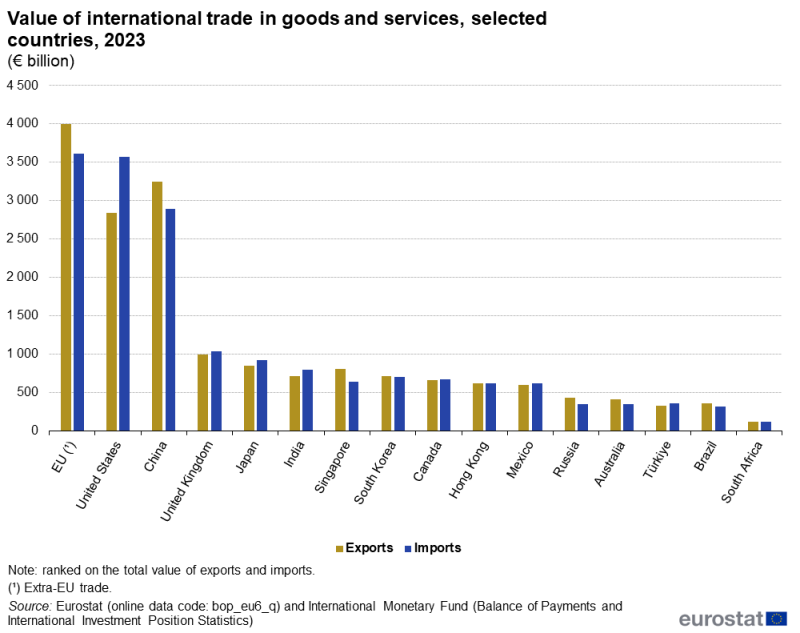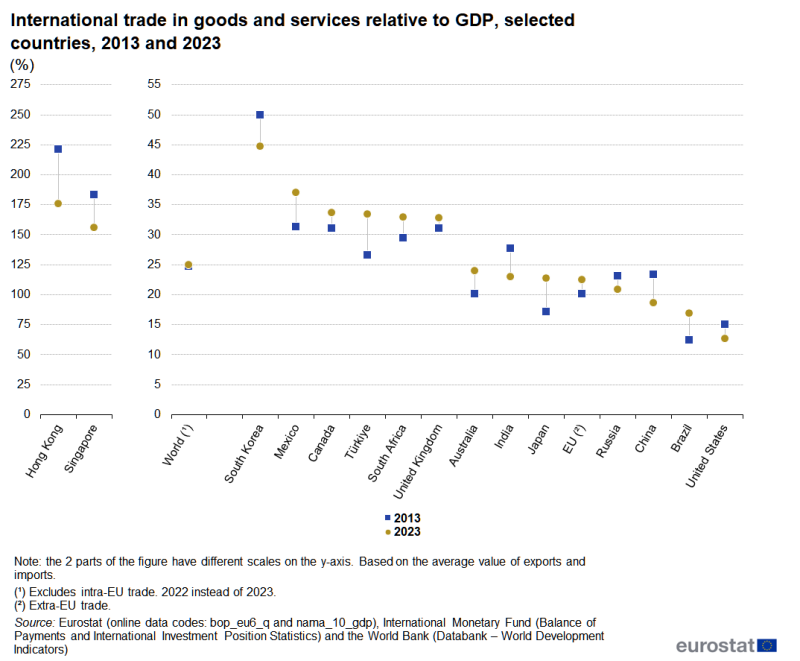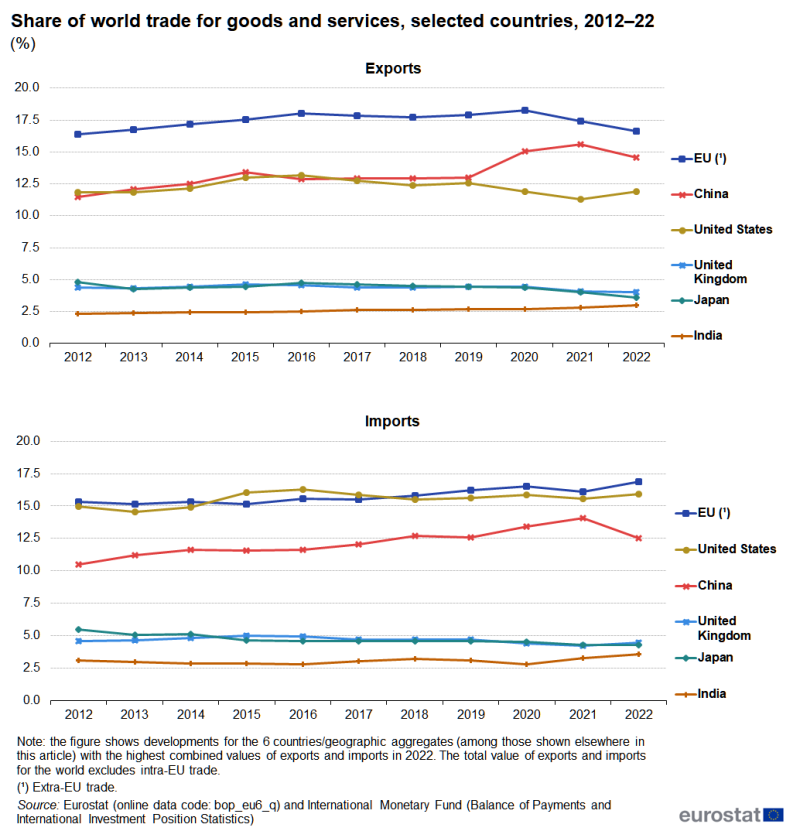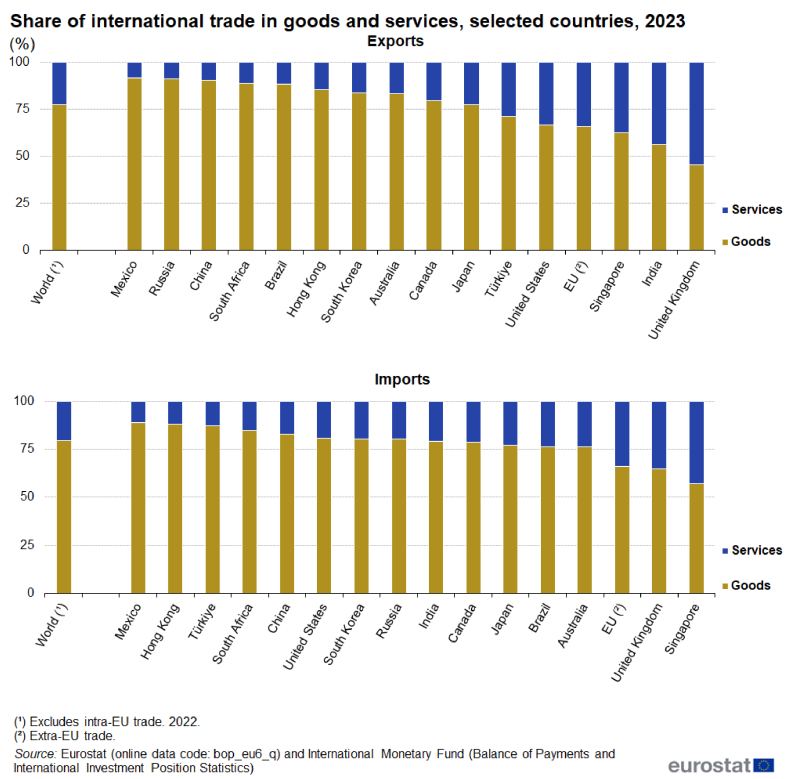Data extracted in July 2024.
Planned article update: February 2026.
Highlights
In 2023, international trade in goods and services was equivalent to 22.4% of the EU’s GDP.
The EU’s share of world exports of goods and services was 16.6% in 2022 (this figure relates solely to extra-EU trade, not to trade within the EU).

(€ billion)
Source: Eurostat (bop_eu6_q) and International Monetary Fund (Balance of Payments and International Investment Position Statistics)
Globalisation patterns in EU trade and investment is an online Eurostat publication presenting a summary of recent European Union (EU) statistics on economic aspects of globalisation, focusing on patterns of EU trade and investment.
Within the context of globalisation, increased levels of trade and cooperation can provide a stimulus to support continued economic development.
Economists tend to agree that ‘open’ economies grow at a faster pace than ‘closed’ ones: international trade has the potential to promote economic growth through increasing external demand for goods and services, while at the same time providing consumers with greater choice (and often lower prices), fostering efficiency and productivity gains, and supporting innovation. Enterprises and households are more likely to consume goods and services from an international partner if such transactions are free from tariffs and other trade barriers, thereby allowing goods and services to cross borders in a frictionless and efficient manner.
In practical terms, this means the European Union’s (EU’s) international trade policy has been designed around promoting reciprocal market opening and trade liberalisation, creating new opportunities for increased levels of trade (for both goods and services), investment, innovation and productivity growth.
Statistics on international trade in goods and services
The main methodological reference used for the production of statistics on international trade in goods and services is the International Monetary Fund’s (IMF’s) Balance of Payments and International Investment Position Manual (BPM6).
World exports of goods and services
World exports of goods and services (excluding intra-EU trade) increased from €19.3 trillion in 2021 (when it was starting to recover from low value in 2020 caused by the COVID-19 crisis) to €24.2 trillion in 2022
In 2019, the global value of exports of goods and services had peaked at €18.1 trillion (or €18 100 billion). The impact of the COVID-19 crisis was apparent insofar as world exports of goods and services fell to €15.9 trillion in 2020 (down 12.1% in current price terms). Exports rebounded in 2021 and 2022, up 21.0% and 25.8%, respectively, to reach a new peak of €24.2 trillion in 2022.
In most large economies, trade levels dropped back somewhat in 2023, although data for the whole world are (at the time of writing) not available. Fresher data are however available for the EU and for many individual countries. Figure 1 shows that the highest levels of trade in goods and services were recorded, unsurprisingly, in some of the biggest economies. In 2023, the EU exported more goods and services (€4.00 trillion) than any individual country and the EU also recorded the highest level of imports (€3.61 trillion), just ahead of the United States (€3.57 trillion).
The largest trade surplus for international trade in goods and services – as measured by the difference between exports and imports – was recorded in the EU (€389 billion in 2023), followed closely by China (€357 billion) and at some distance by Singapore (€173 billion). By contrast, the largest deficit was registered in the United States (€726 billion); its deficit was substantially larger than in any of the other main global economies, as it was followed by India (€80 billion) and Japan (€64 billion).

(€ billion)
Source: Eurostat (bop_eu6_q) and International Monetary Fund (Balance of Payments and International Investment Position Statistics)
Ratio of trade in goods and services relative to GDP
In 2023, international trade in goods and services was equivalent to 22.4% of the EU’s GDP …
The information presented in Figure 2 shows that – between some of the world’s largest trading countries – the importance of international trade in goods and services was quite different when compared with economic output as measured by gross domestic product (GDP). The ratio presented in Figure 2 is based on the average value of exports and imports relative to GDP and provides a means for analysing the ‘depth’ of globalisation or the ‘openness’ of individual economies.
Increased trade liberalisation from the 1990s onwards provided a stimulus for international trade in goods and services. Within the EU, the ratio of international trade in goods and services relative to GDP rose from 20.1% in 2013 to 22.4% by 2023, confirming that trade in goods and services was still growing at a faster pace than the overall EU economy. This relative shift may, at least in part, be attributed to the growing importance of trade in intermediate goods, which itself was driven by higher levels of international outsourcing as global production chains were established.
The information presented is also impacted by the COVID-19 crisis (which was accompanied by a slowdown in global trade flows during 2020) and the recent ongoing period of relatively high inflation. Data for the EU provide evidence as to the impact of the pandemic and price rises, in particular for imported energy products. The ratio of international trade in goods and services relative to GDP peaked at 21.8% in 2019, fell to 20.3% in 2020, increased in 2021 and 2022 to reach a new peak of 25.3% in 2022 and then fell back to 22.4% in 2023.
… while much higher ratios for trade to GDP were recorded in some Asian economies
The highest degrees of exposure to international trade were reported by 2 relatively small Asian economies, as the average value of exports and imports for goods and services in Hong Kong represented 175.8% of its GDP in 2023, while the corresponding ratio for Singapore was 155.6%. These figures could be contrasted with much lower ratios for some of the world’s largest economies – the EU (22.4%), China (18.6%) and the United States (12.7%).
The ratio of trade in goods and services relative to GDP fell between 2013 and 2023 in several of the world’s leading economies, and this was most notable in Asia – for example, in Hong Kong, Singapore, South Korea, China and India. Note that in some of these countries – such as China and India – the domestic economy grew at a faster pace than the value of international trade, even though their shares of world trade also grew (as shown in Figure 3).
The most notable exceptions – where the ratio of trade in goods and services relative to GDP rose most strongly between 2013 and 2023 – were Türkiye, where the ratio increased from 26.6% in 2013 to 33.4% in 2023 (up 6.8 percentage points), Mexico (up 5.6 points) and Japan (up 5.5 points).

(%)
Source: Eurostat (bop_eu6_q) and (nama_10_gdp), International Monetary Fund (Balance of Payments and International Investment Position Statistics) and the World Bank (Databank – World Development Indicators)
The EU’s share of world exports of goods and services was 16.6% in 2022
On average, every day the EU exports and imports millions of euro worth of goods and services to and from the rest of the world. Between 2012 and 2016, the EU’s share of global exports rose; it then fluctuated within the range of 17.7% to 18.3% from 2016 to 2020. In 2021 and 2022, the share fell sharply, down to 17.4% in 2021 and 16.6% in 2022, reaching a share that was about the same as a decade earlier.
The EU’s share of world imports for goods and services was in the range of 15.2% to 15.8% between 2012 and 2018. This share subsequently increased in successive years to reach 16.5% in 2020 before dropping back to 16.1% in 2021 and then increasing in 2022 to a new peak, at 16.9%. As such, in 2022 it stood 1.6 percentage points above its share in 2012.
Despite its share falling in 2022, the most striking feature concerning developments for world shares of international trade in goods and services between 2012 and 2022 was the continued progression of China. China’s share of world exports for goods and services rose from 11.4% to 14.6% during the period under consideration (up 3.1 percentage points), while its share of imports increased 2.1 points to reach 12.5% in 2022 (see Figure 3).

(%)
Source: Eurostat (bop_eu6_q) and International Monetary Fund (Balance of Payments and International Investment Position Statistics)
Trade flows for international trade in goods and services
In 2022, goods accounted for close to four fifths of the world’s exports of goods and services
Figure 4 presents information on the relative importance of trade flows for both international trade in goods and international trade in services (more detailed information on these 2 types of products are provided in separate articles on goods and services). In 2022, goods accounted for 77.6% of the world’s total exports. Fresher data are available for individual countries. In 2023, the share of goods in total exports peaked (among the selected countries) at 91.4% in Mexico and 91.1% in Russia. By contrast, the relative weight of services in total exports was far more pronounced in the United Kingdom (54.4%), India (43.7%), Singapore (37.5%), the EU (34.3%), the United States (33.4%) and Türkiye (28.8%).
The EU recorded a trade surplus for goods in 2023 and a smaller surplus for services; a similar pattern was observed for Singapore. The opposite situation, with a deficit for goods and for services, was recorded for Canada, Japan and Mexico. All of the other economies shown in Figure 4 recorded a combination of a deficit and a surplus.
- Australia, Brazil, China, Russia, South Africa and South Korea all had surpluses for goods and deficits for services resulting in an overall surplus.
- Hong Kong had a deficit for goods and a surplus for services resulting in an overall surplus.
- India, Türkiye, the United Kingdom and the United States had deficits for goods and surpluses for services resulting in an overall deficit.

(%)
Source: Eurostat (bop_eu6_q) and International Monetary Fund (Balance of Payments and International Investment Position Statistics)
Source data for tables and graphs
Context
The provision of services contributes a substantial share of the EU’s economic wealth and accounts for more than 50% of GDP in each of the EU countries. Nevertheless, the value of exports and imports of goods is generally 2 to 3 times as high as that of services. Part of this imbalance may be due to the nature of some services, for example, professional services that are bound by distinct national legislation. Another difference between goods and services concerns the immediacy of the relationship between supplier and consumer: many services are non-transportable, in other words they require the physical proximity of the service provider and consumer, which implies that many services transactions involve factor mobility. For international trade in non-transportable services to take place, either the consumer must go to the service provider or the service provider must go to the consumer. Thus, an important feature of services is that they are provided using various modes of supply. Often services are tailored according to the client’s needs and wishes and so tend not to be homogeneous or mass-produced. As such, services cover a heterogeneous range of products that are difficult to encapsulate within a simple definition, while services may also be difficult to separate from the goods with which they may be associated or bundled. International organisations increasingly recognise that there is a need to explore means of gathering further information as to how services are provided, thus perhaps enabling, in the future, better policymaking internationally and, at the same time, offering complementary information for the purposes of bilateral or multilateral negotiations in trade in services; some steps have already been undertaken in this direction.
Despite the fact that the EU’s level of international trade (with non-EU countries) in services is equivalent to half of the equivalent level for goods, there are a number of reasons to believe that the share of services may grow in future years. Technological developments have increased the tradability of some services, for example by simplifying web-based services in areas such as finance, education, health and government. Furthermore, liberalisation efforts are likely to ease and therefore stimulate international trade in services. Globally, the inclusion of services in the Uruguay Round of trade negotiations led to the general agreement on trade in services (GATS) that entered into force in January 1995. The GATS aims to ensure increased transparency and predictability of relevant rules and regulations and to promote progressive liberalisation through successive rounds of negotiation.
Explore further
Other articles
Database
- Balance of payments – International transactions (BPM6) (bop_6)
- Comext database
- International trade in goods (ext_go), see
- International trade in goods – aggregated data (ext_go_agg)
- International trade in goods – long-term indicators (ext_go_lti)
Thematic section
Selected datasets
- Balance of payments statistics and International investment positions (BPM6) (t_bop_q6)
- International trade in goods, see
- International trade in goods – long-term indicators (t_ext_go_lti)
Methodology
Metadata
- Balance of payments – international transactions (BPM6) (ESMS metadata file – bop_6_esms)
- International trade in goods – aggregated and detailed data (ESMS metadata file – ext_go_agg_esms)
Further methodological information
